Top 6 MSP Trends to Watch in 2024
An industry-wide research into the state of managed service providers concluded that in 2023, the 31 MSP industry trends to watch for were:
- Increased need for automation for MSPs and their clients
- Higher dependency on cybersecurity services
- Constant integration between different business applications
As discussed previously, since businesses become increasingly reliant on managed services, the growth of managed service providers hinges on weathering the scalability challenges of the whole MSP industry.
In this article, we name companies that are exploring the six MSP industry trends that could be shaping the MSP industry, offering insights into the future of managed services.
1. Automation for both MSPs and their clients
90%2 of MSP respondents said that automation and cloud computing is fueling their growth by freeing technicians to focus on business-critical tasks.
For example, RPA is one of the most popular automation tools with the ability to automate between 70-80% of all rule-based tasks within an organization. And with digital transformation poised to add $100T to the world economy by 2025, RPA:
- Is poised to achieve almost universal adoption in the next 5 years
- Market is currently valued at almost $14B
However, adoption barriers and automation challenges, such as3 process fragmentation, and lack of a clear vision critical infrastructure and IT readiness, is stopping the scaling of intelligent automation (IA) (Figure 1). Managed service providers can do more in helping their clients reach a stage of end-to-end automation by navigating them through these said-challenges.
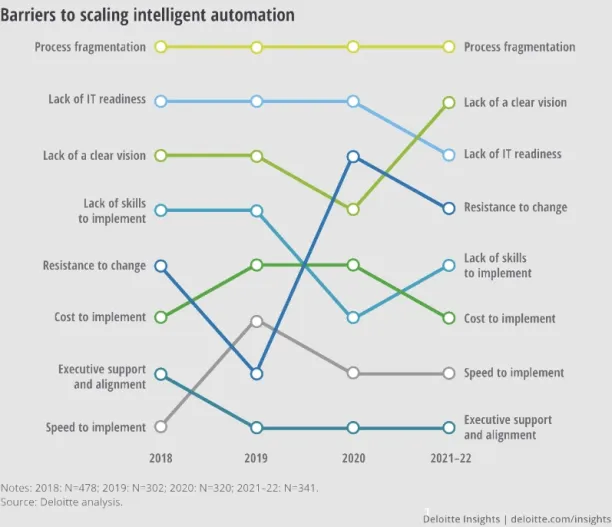
One way is to partner with an RPA technology provider. However, in a saturated market like RPA, it’s not often easy to find a vendor that can meet your and your clients’ needs. You can learn more about the best practices you can follow when choosing an RPA technology partner by reading our whitepaper:
2. Cybersecurity services
Managed services industry should be prepared to offer more4 security solutions to clients. Business operations are under threat from an increasing number of cyberattacks. That’s evident from managed services industry clients now requiring more cybersecurity data protection-related services than they did in 2022 (Figure 2):
- Email security (11 to 15%)
- Security awareness training and phishing testing (7% to 11%)
- Password manager and identity access management (5% to 8%)
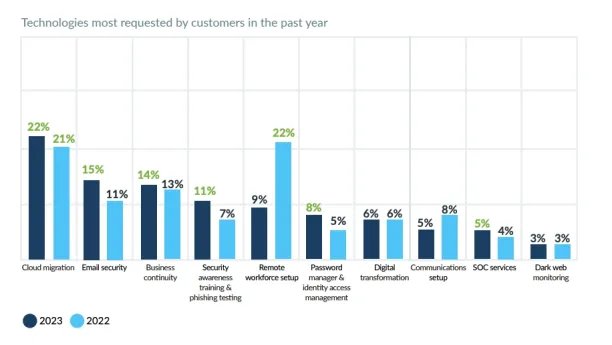
That is why two out of four areas with the highest5 rates of growth for security MSPs have been (Figure 3):
- Enhanced security services
- 2 factor authentication (2FA)
- Intrusion detection systems (IDS) and intrusion prevention systems (IPS)
- Dark web monitoring
- Security awareness training
- Security patch management
- Information and event management
- Penetration testing
- Business continuity and disaster recovery as a service
- Backup and replication
- Disaster recovery plans
- Failover and failback
- Testing and validation
- Monitoring and alerting
- Incident management and support
- Compliance

We expect these areas to keep on growing, also because more MSPs plan on offering the following services6 :
- Regulatory compliance management (39%)
- Managed detection and response (32%)
- Dark web monitoring (32%)
- Identity and access management security (26%)
- Security awareness training (25%)
3. More integrations
90%7 of MSP respondents claimed that integration between different applications is integral to theirs and their clients’ business continuity. Specifically, time wastages due to switching between different apps (18%) and suboptimal usage of applications (39%) are the two biggest barriers to organic growth.
As more MSPs’ clients use different applications and systems, in addition to having a remote workforce, MSPs can use more cloud-based services to streamline their own processes, and in extension, offer a better value-proposition to their clients.
The trend has already taken off. For instance, when it comes to a PSA (professional services automation) solution, the most important feature MSPs will look for is how well they integrate with other tools, such as RMM (remote monitoring and management), remote desktop services, and IT documentation (Figure 4).
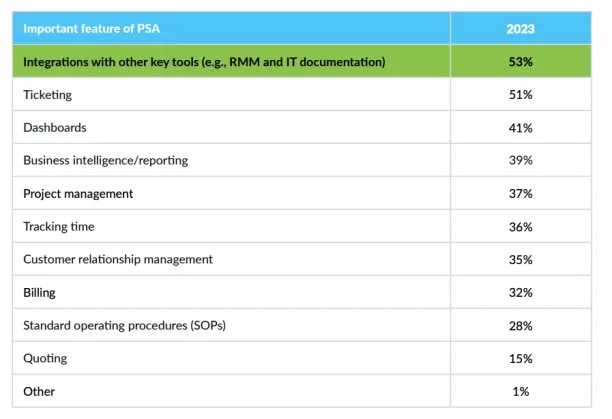
For MSPs, specifically, the benefit of using cloud based servers include:
- Ability to better support remote workers
- Agility to handle planned and unplanned maintenance
- Scalability to handle new clients, even if they are larger companies that need special attention
4. Generative AI/ChatGPT
There’s no specific data on the extent to which MSPs are using generative AI tools, like ChatGPT. But given the evolvement of MSP market in terms of services that’s being provided8 and the higher market demand9, we can expect MSP providers to leverage these tools to increase their efficiency in whatever capacity possible.
For example, MSPs can use ChatGPT for:
- RMM script generation
- Developing incident response plans
- Creating marketing strategies
- Drafting cybersecurity awareness training material
- Writing knowledge-based articles
5. The Internet of Things (IoT)
The IoT MSP market is forecasted to grow at 28% until 202810 As the research puts it, “the rise in multi-cloud applications, automation, and increased IoT demand in the industrial space” is responsible for more customers needing MSPs to manage and monitor their IoT endpoints.
The types of services that MSPs can expect to deliver more of include, but aren’t limited to, the following:
- Remote Monitoring and Management: Tracking device health, performance, and diagnostics in real-time, enabling proactive maintenance and issue resolution.
- Predictive Maintenance: Monitoring the condition of the equipment to identify potential failures or maintenance needs before they occur. This allows MSPs to schedule proactive maintenance activities and minimize downtime for their clients.
- Asset Tracking and Inventory Management: IoT devices such as RFID tags or GPS trackers can be used to track and manage inventory, assets, or fleet vehicles for clients. The use cases would include monitoring locations, conditions, and usage patterns, optimizing inventory management and ensuring efficient operations.
- Security and Surveillance: MSPs can employ IoT devices like IP cameras, motion sensors, or access control systems to enhance security and surveillance services for their clients. These devices can be integrated into a centralized management platform, enabling remote monitoring, alerting, and incident response.
- Data Analytics and Insights: By applying data analytics and machine learning techniques, MSPs can uncover patterns, trends, and actionable intelligence that can drive operational efficiency or improve decision-making.
6. AIOps
A 2023 survey11 of 265 MSPs showed that (Figure 5)
- +60% were adopting AIOps to improve service and application availability and performance
- 58% were using it for operations automation
- 54% were using it for process automation
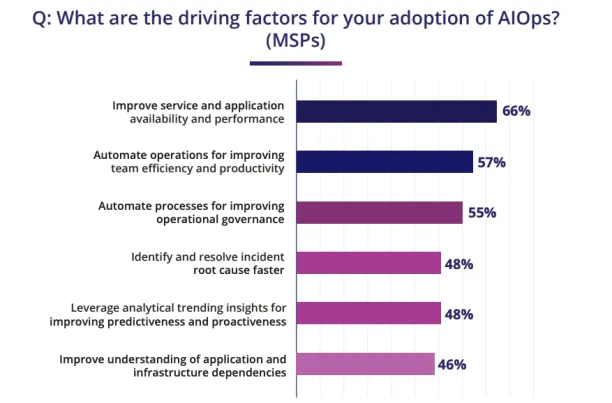
And the specific use cases, in those domains, are (Figure 6):
- Intelligent alerting
- Root cause analysis Anomaly/threat detection
- Incident auto-remediation
- Capacity optimization
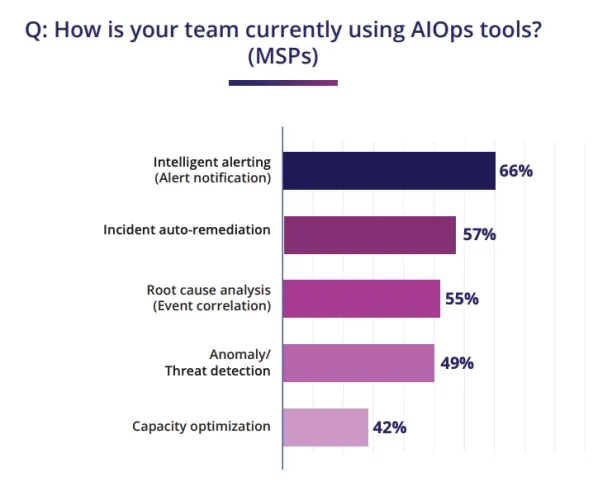
And with the operational benefits of AIOps (Figure 7), we could expect increased adoption of AIOps amongst MSPs.
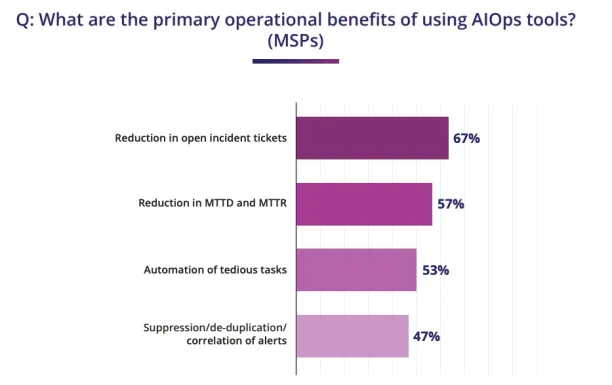
Screen top +15 AIOps platforms in our data-driven and comprehensive benchmarking and learn how AIOps can leverage recent technologies such as ChatGPT.
If you have questions or need help in finding vendors, reach out:
External links
External Links
- 1. “2023 Global MSP Benchmark Survey Report.” Kaseya. Retrieved on May 12, 2023.
- 2. “2023 Global MSP Benchmark Survey Report.” Kaseya. Retrieved on May 12, 2023.
- 3. “Automation With Intelligence.” Deloitte. 30 June, 2022. Retrieved on May 12, 2023.
- 4. “2023 Global MSP Benchmark Survey Report.” Kaseya. Retrieved on May 12, 2023.
- 5. “2023 Global MSP Benchmark Survey Report.” Kaseya. Retrieved on May 12, 2023.
- 6. “2023 Global MSP Benchmark Survey Report.” Kaseya. Retrieved on May 12, 2023.
- 7. “2023 Global MSP Benchmark Survey Report.” Kaseya. Retrieved on May 12, 2023.
- 8. “The MSP Guide to Higher Growth.” Kaseya. Retrieved on May 16, 2023.
- 9. “Managed Services Market to Reach $393.72 Billion by 2028.” GlobeNewswire. July 7, 2022. Retrieved on May 3, 2023.
- 10. “Internet of Things (IoT) Managed Services Market Size & Share Analysis”
- 11. “The State of AIOps 2023” OmpsRamps. March 16, 2023. Retrieved on May 16, 2023.

Cem has been the principal analyst at AIMultiple since 2017. AIMultiple informs hundreds of thousands of businesses (as per similarWeb) including 60% of Fortune 500 every month.
Cem's work has been cited by leading global publications including Business Insider, Forbes, Washington Post, global firms like Deloitte, HPE, NGOs like World Economic Forum and supranational organizations like European Commission. You can see more reputable companies and media that referenced AIMultiple.
Throughout his career, Cem served as a tech consultant, tech buyer and tech entrepreneur. He advised businesses on their enterprise software, automation, cloud, AI / ML and other technology related decisions at McKinsey & Company and Altman Solon for more than a decade. He also published a McKinsey report on digitalization.
He led technology strategy and procurement of a telco while reporting to the CEO. He has also led commercial growth of deep tech company Hypatos that reached a 7 digit annual recurring revenue and a 9 digit valuation from 0 within 2 years. Cem's work in Hypatos was covered by leading technology publications like TechCrunch and Business Insider.
Cem regularly speaks at international technology conferences. He graduated from Bogazici University as a computer engineer and holds an MBA from Columbia Business School.
To stay up-to-date on B2B tech & accelerate your enterprise:
Follow on
Comments
Your email address will not be published. All fields are required.